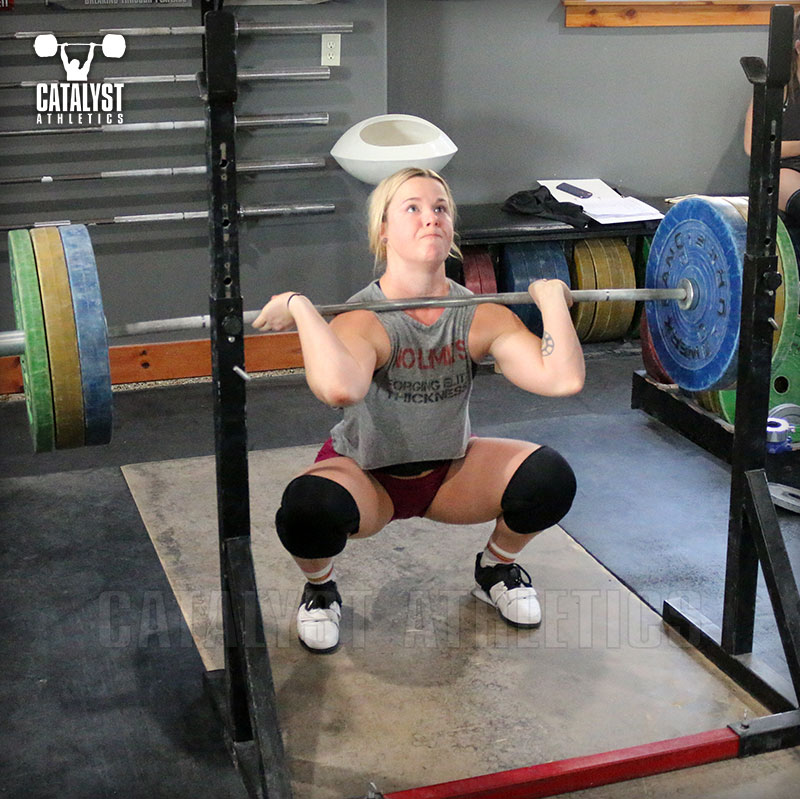Articles
Ask Greg: Hips Shooting Back in Squats & Cleans
March 7 2018

March 7 2018

Christopher Asks: What to do if my butt/hip shoots back in back squat, front squat and clean?
There are a couple possibilities here: your hips are really shooting up, i.e. rising faster than your shoulders momentarily, and because of the fact that they hinge around the knee, they naturally move backward as a part of this motion; or your hips are actually moving backward primarily.
The latter problem is often the result of limited ankle mobility. This prevents the shins/knees from moving forward adequately in the bottom of the squat, or creates excessive tension at the ankle when they do move forward into position, resulting in the tendency for the legs to rebound backward in response to that tension. The solution to this of course is improving ankle mobility, which is a slow process, but also actively focusing on standing straight up and leading with your chest as you transition out of the bottom of the squat—in other words, actively fighting that tendency. Pause squats can be helpful as well—they will help improve ankle mobility in the function of a loaded stretch, and will also allow you to recover from the bottom of the squat without the backward rebound that will occur in a squat of normal tempo, therefore helping to retrain the pattern.
If the problem is actually the hips rising faster than the shoulders, which means you’re tipping over as you stand, it’s more likely an issue of relative leg and hip strength (the legs are weaker than the hips). A deep squat involves a very small angle at the knee joint, which is very difficult for the quads to open. By shifting the hips up (and back) without moving the weight commensurately, the body can redistribute the effort among the quads, glutes and hamstrings.
To strengthen the ability to recover from the squat with the desired posture, train a lot of pause squats (never pushing the weight past the threshold at which you can maintain the correct posture—otherwise you’re just reinforcing the problem). You can also use slow eccentrics in the squat, again ensuring the proper position—this allows you to strengthen that proper position in the absence of the tendency to shift. Finally, like the above, you need to actively fight to maintain the correct position—drive your head and shoulders up first and follow the bar with the rest of your body.
There are a couple possibilities here: your hips are really shooting up, i.e. rising faster than your shoulders momentarily, and because of the fact that they hinge around the knee, they naturally move backward as a part of this motion; or your hips are actually moving backward primarily.
The latter problem is often the result of limited ankle mobility. This prevents the shins/knees from moving forward adequately in the bottom of the squat, or creates excessive tension at the ankle when they do move forward into position, resulting in the tendency for the legs to rebound backward in response to that tension. The solution to this of course is improving ankle mobility, which is a slow process, but also actively focusing on standing straight up and leading with your chest as you transition out of the bottom of the squat—in other words, actively fighting that tendency. Pause squats can be helpful as well—they will help improve ankle mobility in the function of a loaded stretch, and will also allow you to recover from the bottom of the squat without the backward rebound that will occur in a squat of normal tempo, therefore helping to retrain the pattern.
If the problem is actually the hips rising faster than the shoulders, which means you’re tipping over as you stand, it’s more likely an issue of relative leg and hip strength (the legs are weaker than the hips). A deep squat involves a very small angle at the knee joint, which is very difficult for the quads to open. By shifting the hips up (and back) without moving the weight commensurately, the body can redistribute the effort among the quads, glutes and hamstrings.
To strengthen the ability to recover from the squat with the desired posture, train a lot of pause squats (never pushing the weight past the threshold at which you can maintain the correct posture—otherwise you’re just reinforcing the problem). You can also use slow eccentrics in the squat, again ensuring the proper position—this allows you to strengthen that proper position in the absence of the tendency to shift. Finally, like the above, you need to actively fight to maintain the correct position—drive your head and shoulders up first and follow the bar with the rest of your body.

What about long-legged lifters? If hips raising slightly faster than shoulder it is always a mistake for us? For example 3rd and 4th repetition from this video: https://vimeo.com/259188440
Greg Everett